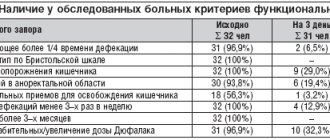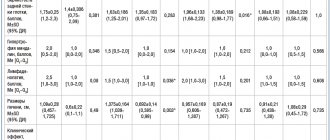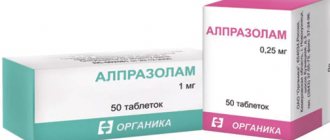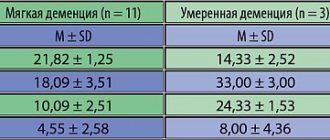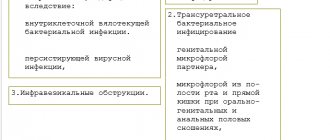Bellataminal®
Bellataminal® is a combination drug. It has α-adrenergic blocking, m-anticholinergic and sedative effects, and has antispasmodic properties. The drug reduces the excitability of the central and peripheral adrenergic and cholinergic systems of the body, has a calming effect on the central nervous system (CNS), and has some antispasmodic effects.
The pharmacological properties of the drug are determined by the action of the components included in its composition.
Belladonna's sum of alkaloids (alkaloids of the atropine group) has an m-anticholinergic and antispasmodic effect. Interferes with the stimulating effect of acetylcholine; reduces the secretion of the salivary, gastric, bronchial, lacrimal, sweat glands, and the exocrine function of the pancreas. Reduces the tone of the muscles of the gastrointestinal tract, bile ducts and gallbladder, but increases the tone of the sphincters; causes tachycardia, improves atrioventricular conduction. Dilates the pupils, impedes the outflow of intraocular fluid, increases intraocular pressure, causes paralysis of accommodation, etc.
Phenobarbital belongs to the group of barbiturates. It interacts with the barbiturate portion of the benzodiazepine-γ-aminobutyric acid receptor complex, thereby increasing the sensitivity of γ-aminobutyric acid receptors to γ-aminobutyric acid, leading to the opening of neuronal channels for chloride ions, which leads to an increase in their entry into the cell.
Suppresses the sensory zones of the cerebral cortex, reduces motor activity, and inhibits cerebral functions, including the respiratory center. Reduces the tone of the smooth muscles of the gastrointestinal tract. Has a sedative effect.
Ergotamine is an ergot alkaloid. Affects various organs and systems of the body, incl. on the central nervous system; increases the tone of the uterus. It has been established that ergotamine is characterized by α-adrenergic blocking activity in combination with a pronounced direct vasoconstrictor effect on the smooth muscles of peripheral and cerebral vessels. In this regard, against the background of the action of ergotamine, despite its α-adrenergic blocking activity, the tonic effect on peripheral vessels and cerebral vessels predominates. It has a direct stimulating effect on the smooth muscles of the vessels of the skull, causing their constriction due to binding to 5-HT1-serotonin receptors, which leads to their activation.
Bellataminal
Bellataminal (belladonna alkaloids + ergotamine tartrate + phenobarbital) is a combination drug that combines the properties of an alpha-blocker, an m-anticholinergic blocker and a sedative. The list of indications for taking bellataminal has a wide therapeutic range: from increased irritability and sleep disorders to skin diseases and menstrual disorders. The drug has proven itself in the relief of post-concussion syndrome (PCS), a pathological condition that occurs in people who have suffered a traumatic brain injury. Headaches, vertigo, memory and attention disorders, depressive and anxiety states are quite common post-traumatic phenomena. As a rule, brain functions are restored within 2-3 months and the above symptoms disappear. However, in some cases, signs of ACL persist for a longer time. As some sources indicate, manifestations of ACL six months after a mild traumatic brain injury occur in 15–30% of patients. The optimal treatment strategy for patients with ACL is still a matter of debate. Clinicians are in a very difficult situation: on the one hand, they need to eliminate the cognitive, affective and autonomic symptoms of PCS, on the other hand, they need to avoid oversaturating the patient with sedatives that depress cognitive functions. In this regard, the domestic drug bellataminal is of particular interest. Russian scientists conducted a study of its effectiveness in patients with ACL. The study assessed the effect of the drug on the severity of the main symptoms of PCS and its safety. Two groups of patients were formed: participants in one of them took bellataminal 1 tablet 3 times a day for 30 days, participants in the other formed a control group. The severity of clinical and subjective symptoms was assessed using a specially developed scale before and at the end of pharmacotherapy. By the end of the 1st month of treatment, a statistically significant decrease in the severity of ACL symptoms was recorded in the experimental group compared to the initial level.
Compared with the control group, patients taking the drug had lower rates of headache, vertigo, nausea, sensitivity to light, emotional instability and irritability. Thus, in the experimental group, improvement was noted more often than in the control group, and a pronounced regression of symptoms due to bellataminal was observed twice as often as in the comparison group. In addition, the drug showed good results in terms of safety for patients: minor side effects such as dry mouth, drowsiness, lethargy and headache were observed in only 7% of patients. However, in none of the cases was it necessary to discontinue bellataminal.
The drug can also be effective in the treatment of dermatological diseases. Previously, bellataminal was quite actively used to reduce psycho-emotional overload in atopic dermatitis, dyshidrotic eczema, and itchy dermatoses. In recent years, due to global warming, the problem of treating prickly heat has become particularly relevant. Considering the presence of sedative and m-cholinergic effects in bellataminal, clinicians have proposed this drug as a means of direct and indirect reduction of excessive sweating. A study conducted at the Department of Dermatovenereology and Cosmetology of the Institute of Pedagogy of the Federal Medical and Biological Agency of Russia confirmed the effectiveness of bellataminal in the complex treatment of prickly heat.
Bellataminal is available in tablets. The drug is taken 1 tablet 2-3 times a day after meals. The duration of the drug course varies from 2 to 4 weeks with the possibility of a second course after agreeing on this issue with the attending physician. Bellataminal contains potent components, so it is not superfluous to know the symptoms of a drug overdose: lethargy, tachycardia, impaired accommodation, lack of normal intestinal tone, convulsions. The action of bellataminal is potentiated by nicotine, alpha and beta adrenergic agonists.
Experience with the use of Bellataminal in patients with gastrointestinal diseases
Diseases of the gastrointestinal tract (GIT) in 45–90% of cases lead to damage to the nervous system. The nervous system in diseases of the gastrointestinal tract is involved primarily at the beginning of the formation of somatic pathology, determining neurosomatic mechanisms, and secondarily as a manifestation of somato-neurological disorders. Patients with this pathology experience psychopathological disorders in the form of anxiety and depressive disorders, as well as autonomic dysfunctions predominantly at the suprasegmental level. Dysfunction of the autonomic nervous system (ANS) is considered as a pathogenetic factor in non-infectious gastrointestinal pathology. The connection between the ANS and gastroduodenal motility, which plays an important role in the development of gastroduodenal pathology (GDP), has been studied. One of the reasons for the chronicity of the pathological process in the mucous membrane of the gastroduodenal zone is sphincter disorders, the manifestations of which are duodenogastric reflux (DGR) and gastroesophageal reflux (GER). In the development of sphincter disorders, a priority role is given to dysfunction of the ANS [7]. A relationship has been established between the state of the parasympathetic division of the ANS and the presence of GDR in patients with chronic gastroduodenitis (CGD). In the pathogenesis of chronic gastroduodenal pathology (CGDP), an important role is given to the functioning of the ANS, because It has been proven that CGDP occurs as a result of the depletion of protective and adaptation mechanisms. The prevalence of parasympathetic regulation, leading to disruption of the secretory-motor function of the stomach, is considered as a possible mechanism for the formation of HDP. Violation of the trophism of the gastric mucosa is explained by a decrease in the activity of the sympathetic component of the ANS [2,4,6,9]. Materials and methods of research. Clinical examination of patients was carried out using standard methods and included analysis of anamnestic information, assessment of complaints, neurological and somatic status, and psychological testing of a number of features of the emotional sphere. In order to exclude organic changes in the somatic sphere of patients, a comprehensive laboratory and instrumental examination was carried out. Ultrasound of the abdominal organs with cholecystoscopy and esophagogastroduodenoscopy (EFGDS) were used. Laboratory diagnostic methods included standard studies of hemogram, urogram, coprogram, basic biochemical parameters of blood serum (total protein, albumin, bilirubin, liver transaminases, glucose, amylase, alkaline phosphatase, electrolytes). We used rapid diagnostics of Helicobacter pylori infection using the HELIK test system. All patients underwent a comprehensive examination before and after completion of the course of therapy, which included an assessment of the state on the Spielberger-Khanin scale of reactive and personal anxiety, which allows one to judge the severity of changes, a study of autonomic dysfunction (questionnaires edited by A.M. Vein), and a scoring questionnaire was used subjective characteristics of sleep (edited by V.L. Golubev, 2010). Research results. 31 patients (12 boys, 19 girls) aged 17–18 years were observed. Their main complaints were abdominal pain, heartburn and belching. Pain syndrome was observed in 100% of patients, while heartburn was noted by 13 (41.9%), belching – by 23 (74%), not only with air, but also with sour or bitter air. Quite often, patients had complaints such as heaviness and discomfort in the abdomen and nausea: 12 (38.7%), 6 (19.3%) and 13 (54.8%), respectively; 8 patients (25.8%) complained of bitterness in the mouth. These complaints are characteristic signs of impaired motility of the upper digestive tract. The defining symptoms of impaired motility of the lower digestive tract were flatulence - in 4 (12.9%) and pathological frequency of stool - in 10 (32%) of those examined. Based on the results of EGD, an analysis of endoscopic changes in the mucous membrane of the upper gastrointestinal tract in patients included in the study was carried out. All of them had inflammatory changes of varying severity in the esophagus, stomach and duodenum. Inflammatory changes in the mucous membrane of the esophagus were represented by catarrhal esophagitis (1st degree esophagitis) in 3 (9.7%) patients. In 1 (3.2%) patient, erosive changes in the esophageal mucosa were detected - single erosions (2nd degree esophagitis). Motor disturbances in the area of the cardioesophageal junction in the form of cardia insufficiency and GER were detected according to EGD data in 3 (9.7%) and 1 (3.2%) patient, respectively. Endoscopically visualized superficial gastritis - in 14 (45.1%), follicular gastritis - in 1 (3.2%), superficial gastritis and superficial duodenitis - in 16 (51.6%) people. Motility disorders in the pyloroduodenal zone in the form of DGR according to EGD data were more common - they were observed in 11 (35.4%) patients, pyloric sphincter insufficiency was determined in 8 (25.8%) patients. Biliary dysfunction was confirmed by echography in 100% of those examined. In 29.1% of patients, Helicobacter pylori infection was detected using a urease breath test. The girls were characterized by emotional lability, tearfulness, unstable mood, suspiciousness, and a tendency to dramatize their condition. In young men, irritability, hot temper, a decrease in the degree of self-control, and a pessimistic assessment of their condition predominated. Taking into account the emotional state of patients, Bellataminal was added to the basic treatment of gastrointestinal diseases - a combination drug containing belladonna alkaloids, phenobarbital and ergotamine, which has α-adrenergic blocking, M-anticholinergic and sedative properties. The drug was prescribed 1 tablet 2 times a day. All patients had sleep disturbances (difficulty falling asleep, shallow night sleep). A score was made for the time of falling asleep, duration of sleep, presence of night awakenings, dreams, quality of sleep, quality of awakening before and after the use of Bellataminal (Table 1). During the treatment, there was a significant improvement in the quality of sleep of patients, which had a positive effect on psycho-vegetative manifestations. Autonomic dysfunction of varying severity was observed in all patients before taking Bellataminal in complex therapy. The severity according to subjective criteria was 48.7±1.83; according to objective indicators, the average score was 50.5±2.14. After using the drug, there was a decrease in the manifestations of autonomic lability both in subjective (34.4±1.9; p<0.05) and (32.5±2.04; p<0.05) objective indicators. When assessing the level of anxiety before using Bellataminal, both reactive and personal anxiety also prevailed (Table 2). The results presented in the table indicate that treatment with Bellataminal led to a significant improvement in indicators of personal and reactive anxiety. Conclusion. A chronic inflammatory process that develops in the entire body system causes disorders of the nervous system. In this regard, patients of childhood and adolescence with diseases of the digestive system are characterized by emotional lability, anxiety disorders, and sleep disorders. An important link in the formation of pathology of the digestive system is dysfunction of the ANS. The use of Bellataminal in the complex therapy of gastrointestinal diseases leads to a marked reduction in the manifestations of autonomic dysfunction, personal and reactive anxiety, as well as normalization of the gastrointestinal tract. The complex use of medications in combination with the normalization of physical and neuropsychic stress can significantly reduce the number of esophagitis and gastroesophageal reflux disease and the development of complications that arise from this pathology in patients of childhood and adolescence.
Literature 1. Autonomic disorders: Clinic, treatment, diagnosis / ed. A.M. Veina. M.: Medical Information Agency, 1998. 752 p. 2. Belmer S.V., Gasilina T.V., Khavkin A.I., Eiberman A.S. Functional disorders of the digestive system in children. M.: RGMU, 2005. 36 p. 3. Lobakov A.I., Belousova E.A. Abdominal pain: difficulties of interpretation and methods of relief // Medical newspaper. 2001. No. 05. 4. Rational pharmacotherapy of diseases of the digestive system: A guide for practicing physicians. / Under the general editorship. V.T. Ivashkina. M.: Litterra, 2003. 1046 p. 5. Somatoneurology: a guide for doctors / ed. A.A. Skoromets. St. Petersburg: SpetsLit, 2009. 655 p. 6. Khavkin A.I., Belmer S.V., Volynets G.V., Zhikhareva N.S. Functional diseases of the digestive tract in children. Principles of rational therapy // Pediatrician's Handbook. 2006. No. 2. P. 17–32. 7. Shcherbakov P.L. Gastroesophageal reflux disease in children // Diseases of the digestive organs. 2007. T. 9. No. 2. P. 42–47. 8. Gottrand F. The role of Helicobacter pylori in abdominal pain in children // Arch Pediatr. 2000 Feb. Vol. 7(2). R. 197–200. 9. Rasquin–Weber A., Hyman PE, Cucchiara S., Fleisher DR, Hyams JS, Milla PJ, Staiano Childhood functional gastrointestinal disorders // Gut. 1999. Vol. 45. Suppl. 2.P. 1160–1168.

